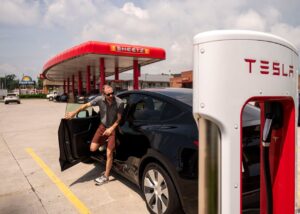
Last year, Foodservice IP posted an article about how a brand’s reputation for clean, inclusive restrooms can be an asset that draws in consumers and drives sales at convenience stores and restaurants. It got us thinking—what other non-food assets should foodservice operators consider as customer incentives? In a time when retail prices remain high, what improvements can increase sales without adding unreasonable demands to staff?
Electric vehicles charging stations come to mind.
After all, Sheetz and Wawa built large foodservice brands by upselling commuters and travelers who want to fuel up their vehicles. Why not EV charging stations? While these ports could be the gas station of the future, there are a few key things you should keep in mind if you are considering installing them.
Charging Habits Differ from Refueling Habits
Filling your tank with gas is another errand—you fit it in when you are driving to and from work, or on your way to get groceries. Charging an EV is different. According to Pew Research, EV owners tend to charge their cars at home. So while city dwellers with no off-street parking may flock to Costco to charge their cars, most EV drivers probably will not add your station to their daily or weekly routine.
Long haul drives, however, are a different story. The Department of Energy estimates that there are approximately 50,000 public EV charging stations across the United States. While that sounds like a lot, most of them take an hour or two to charge a car battery. Less than 7,000 stations are DC fast chargers—the ones capable of powering an EV in 30 minutes. This means that if you have a fast charge port somewhere on an interstate travel corridor, EV travelers will seek you out.
30 Minutes of Customer Time
According to The Hustle, most gas station customers will not enter the store on a given trip, and those who do will only spend 2-3 minutes inside. A fast charger customer, however, will be at your location for approximately 30 minutes. This expands the kinds of products that appeal to your fuel focused customer. Instead of a quick grab and go snack, an EV customer will have time for a full meal or browsing groceries, entertainment, or novelty items.
While this 30-minute time frame means they will potentially spend more money on products, it also means they will have more time to find fault in your facilities. In anticipation of this, your restrooms and seating areas should be pleasant spaces (a feature most gas stations are not known for).
The Bottom Line
According to BP executives, a fast-charging station is nearly as profitable to them as a fuel pump. While most foodservice operators will probably not operate chargers at BP’s scale and profitability, chargers could be an effective loss leader or revenue neutral draw to bring in relatively high value customers. In addition, chargers do not create large demands on your staff once installed.
By focusing on locations near interstate travel corridors and delivering quality food and amenities targeted at a 30-minute visit, you can turn EV chargers into a new, light touch customer draw for your foodservice business.
To learn more about FSIP’s Management Consulting Practice, click here.
Like the content? Sign up to receive our communications.
Recent Comments